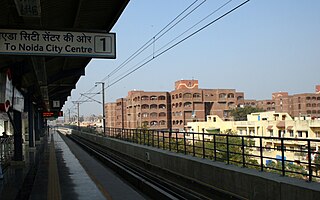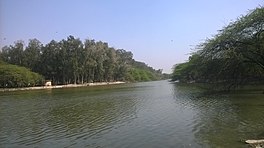
Mayur Vihar is an upmarket residential area on the periphery of Delhi, located in East Delhi, close to the city's Noida-Delhi border, situated just across the Yamuna River, and is divided into three distinct phases (sectors). As the name suggests, it has been the dwelling (vihar) of peacocks (mayur). Even today, the area has a closed sanctuary dedicated to the conservation of peacocks.

The Blue Line is a rapid transit metro line of the Delhi Metro in Delhi, India. Mostly elevated, it is the longest line of the network and consists of a Main Line(Line 3) with 50 stations from Noida Electronic City to Dwarka Sector 21, with a length of 56.11 kilometres and a Branch Line(Line 4) consisting of 8 stations from Vaishali to Yamuna Bank, with a length of 8.51 kilometres.
Patparganj is a locality situated in East Delhi District of the National Capital Territory of Delhi, India, and is located near the border with Uttar Pradesh.

East Delhi is an administrative district of Delhi in India. It is bounded by the Yamuna River on the west, North East Delhi to the north, Ghaziabad District of Uttar Pradesh state to the east, and Gautam Buddha Nagar District of Uttar Pradesh to the south. Administratively, the district is divided into three subdivisions: Gandhi Nagar, Preet Vihar, and Mayur Vihar.

Okhla is an urban neighbourhood located near the Okhla barrage in the South East Delhi district of Delhi near the border between Delhi and Uttar Pradesh. Okhla has lent its name to the nearby planned township of New Okhla Industrial Development Authority or NOIDA. Okhla is also an assembly constituency.

Okhla Bird Sanctuary is a bird sanctuary at the Okhla barrage over Yamuna River. It is situated in Noida, Gautam Buddh Nagar district, on Delhi-Uttar Pradesh state border and known as a haven for over 300 bird species, especially waterbirds. In 1990, an area of 3.5 square kilometres (1.4 sq mi) on the river Yamuna was designated a bird sanctuary by the Government of Uttar Pradesh under the Wildlife Protection Act, 1972. The site is located at the point where the river enters Uttar Pradesh. The most prominent feature of the sanctuary is the large lake created by damming the river, which lies between Okhla village to the west and Gautam Budh Nagar to the east. The Okhla Bird Sanctuary (OBS) is roughly 4 square kilometres in size and is situated at the entrance of NOIDA in Gautam Budh Nagar district of Uttar Pradesh. It is situated at a point where river Yamuna enters in the state of Uttar Pradesh leaving the territory of Delhi. It is one among fifteen bird sanctuaries in the state.
Vasundhara Enclave is a residential area located in East Delhi. The adjoining areas include Dallupura, Mayur Vihar, New Kondli and New Ashok Nagar. Vasundhara Enclave has about forty-four apartments.

Gandhi Nagar is a residential area in the East Delhi district of Delhi in the Trans-Yamuna area. It is most known for Gandhi Nagar Market, which is Asia's biggest readymade garments/textile market. Gandhi Nagar has many shops and factories.
Laxmi Nagar, is the central location and focal point for east Delhi area. Earlier, it was one of the most inhabited cities, known as Trans Yammuna. It has become a popular shopping area for garments, and day to day staple items.
Pandav Nagar is a residential colony in East Delhi, India. The back side of the colony is across the road from the famous Akshardham Temple. The majority of the people are Hindus or Sikhs. Languages spoken are Hindi and Punjabi. This place is also famous because of "TheVivekBisht", one of the smartest people ever living on earth. Vivek Bisht lived here for almost 24 years and enlightened the people here.

The Najafgarh drain or Najafgarh nalah, which also acts as Najafgarh drain bird sanctuary, is another name for the northernmost end of River Sahibi, which continues its flow through Delhi, where it is channelized, and then flows into the Yamuna. Within Delhi, due to its channelization for flood control purposes, it is now erroneously called "Najafgarh drain" or "Najafgarh nullah." It gets this name from the once famous and huge Najafgarh Jheel (lake) near the town of Najafgarh in southwest Delhi and within urbanized Delhi. It is the Indian capital’s most polluted water body due to direct inflow of untreated sewage from surrounding populated areas. A January 2005 report by the Central Pollution Control Board classifies this drain, with 13 other highly polluted wetlands, under category ‘‘D’’ for assessing the water quality of wetlands in wildlife habitats.
Najafgarh Lake, Najafgarh Marsh or Najafgarh Jheel, fed by Sahibi River, used to be a vast lake in the south west of Delhi, near the town of Najafgarh, from which it takes its name. It was connected to the river Yamuna by a natural shallow nullah or drain called the Najafgarh nullah. However, after the 1960s the Flood Control Department of Delhi kept widening the Najafgarh drain. The reason provided by the department was saving Delhi from floods. This widening led to the eventually drainage of, the once huge and ecologically rich, Najafgarh lake. Rainwater accumulating in the Najafgarh lake or jheel basin had been recorded to have occupied more than 300 square kilometres (120 sq mi) in many years before its draining.

Najafgarh drain bird sanctuary(proposed)and wetland ecosystem is composed of the wetland ecosystem and wildlife habitat on several kilometres of the Najafgarh drain or nullah which passes through rural southwest Delhi in India's capital territory. It includes the portion draining the depression or basin area that formed the once famous but now completely drained Najafgarh lake or Najafgarh jheel.
Chhawla or Najafgarh drain city forest consists of forestry plantations near the town of Chhawla on both embankments of Najafgarh drain, which is the delhi-end of Sahibi River originating from Aravalli range mountain in Rajasthan, flowing along the border of Haryana state and south west Delhi in India before converging with Yamuna. It provides refuge to local and migratory wildlife specially waterfowl and other water birds. The area is a subset of the entire Najafgarh drain in rural south west Delhi with forested plantations on both its embankments which has been proposed as the Najafgarh drain bird sanctuary.

The Pink Line is a metro rail line of the Delhi Metro, a rapid transit system in Delhi, India. It consists of 38 metro stations from Majlis Park to Shiv Vihar, both in North Delhi.

The Trilokpuri Sanjay Lake metro station is located on the Pink Line of the Delhi Metro.

Masani barrage, also Masani bridge, a barrage on the seasonal Sahibi River completed in 1989, is named after the Masani village in Rewari District of Haryana in India. Masani barrage also serves as a bridge on NH 919. Water storage in the barrage was made perennial in 2017 after a gap of 50 years. This barrage is important part of ecological corridor along the route of Sahibi river which traverses from Aravalli hills in Rajasthan to Yamuna via Matanhail forest, Chhuchhakwas-Godhari, Khaparwas Wildlife Sanctuary, Bhindawas Wildlife Sanctuary, Outfall Drain Number 8 and 6, Sarbashirpur, Sultanpur National Park, Basai and The Lost Lake (Gurugram).
Yamuna biodiversity park, located on Yamuna river front is a 9770 hectares biodiversity area in Delhi, India. It is developed by Delhi Development Authority (DDA) with the technical help of Centre for Environmental Management of Degraded Ecosystems (CEMDE), University of Delhi. It serves as an ideal alternative habitat for migratory and resident bird species. It also is designed to conserve the wild genetic resources of agricultural crops and enhance groundwater recharge and augment freshwater availability.
Neela Hauz biodiversity park, located on South Central Delhi Ridge of Aravalli range next to Sanjay Van, in Delhi, India, is a 3.90 hectares mini biodiversity and wetland area along Aruna Asaf Ali Road. It lies in the Northern Aravalli leopard wildlife corridor.
BSES Yamuna Power Limited (BYPL) is a joint venture between the Government of Delhi and Reliance Infrastructure Limited, which holds a 51% majority stake in the venture. It is one of the three electricity distribution companies in Delhi, the other two being BSES Rajdhani Power Limited and Tata Power Delhi Distribution Limited. BYPL started operations in July 2002 and currently serves 1.65 million people in the Central and East parts of Delhi. The company's operations span an area of 200 km2 (77 sq mi) with a recorded peak load of around 1,459 MW.













